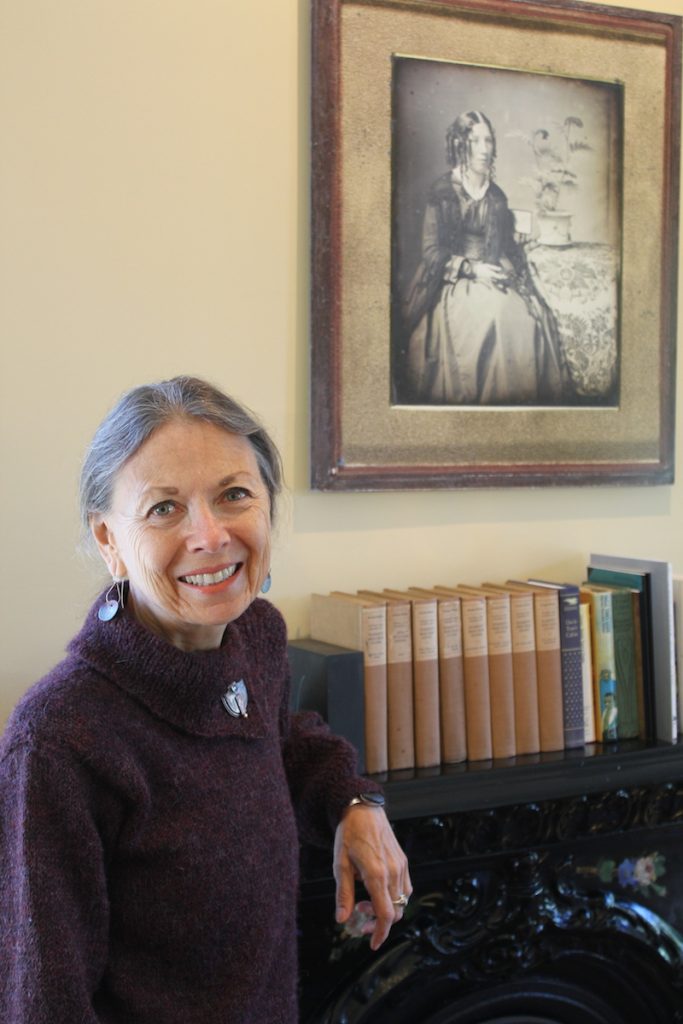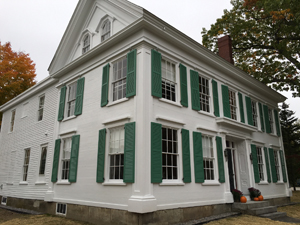Harriet Beecher Stowe, Her House, Her Novel: The Most Common Questions
By Rebecca Goldfine
Cathi Belcher, the first guide of the newly renovated Harriet Beecher Stowe House, has begun holding monthly “Tea with Harriet” events, inviting visitors into the home where Stowe wrote her famous anti-slavery novel, Uncle Tom’s Cabin. Over tea, visitors can listen to a short talk or reading on some aspect of Stowe’s life, work, or times.
The Teas are the third Thursday of each month from 1 p.m.-2:30 p.m. The house is open each week, Thursday to Saturday, from noon to 3 p.m. Belcher also schedules groups by special appointment.
Belcher said she has had marvelous conversations in Harriet’s Writing Room, a front parlor that’s been converted into a commemorative and contemplative space that encourages people to engage with Stowe’s literary legacy. “Some visitors have come over to do some writing of their own or to read, and others just to soak up her spirit which is very much still present here,” she said.
Below Belcher answers some of the most frequently asked questions by visitors to the house.
Did Harriet write Uncle Tom’s Cabin in Harriet’s Writing Room?
Although this is a big house, it was shared with many members of her large family, which included Harriet, her husband, their six children (one of whom was born in the house right after they arrived), and for part of the time, her sister Catharine. Some of the children of Bowdoin professors also spent time in the house during the day, as Harriet and Catharine ran a small school from the house. There were likely a couple of domestics who lived at the house as well. It all made for a lively household! While I’m sure she probably wrote some of the novel in what we today call Harriet’s Writing Room, it’s likely that Harriet wrote in every room at some point, just to seek out some much-needed solace and a quiet space in which to collect her thoughts and write them down. We do know that she read out loud to her children and some Bowdoin students (including Joshua Chamberlain), probably in this parlor or the adjacent one just opposite the front entry.
Is the fireplace mantle original?
The beautiful fireplace fronts here at 63 Federal Street are original to the house, but added after Harriet’s time here. While she was in residence, the house was actually in poor physical shape. She writes in her letters that the chimneys smoked, the cistern in the cellar leaked, and her sink gave her nothing but problems. After she left, the house was sold and renovated by the new owners in a grand style.
Is the color of the (distinctive green) shutters original?
Don Borkowski, Bowdoin’s Director of Capital Projects, has told us that during the research for the Historic Structures Report, extensive research was conducted by a specialized consultant brought in to sample the finishes (i.e. paint colors) of the house. Core samples from the original finishes were taken which revealed the original color of the shutters, doors, walls, trim, etc. The color you see now on the new shutters indeed matches the original color found on the old shutters. However, we have no way of knowing if the shutters that were tested were actually on the house when Harriet lived there, or if they were added later. We went back in time as far as the historical evidence would allow us to go, and didn’t simply pick the color because it was pretty or previously popular.
What did Harriet’s husband Calvin teach at Bowdoin?
Calvin Stowe, a Bowdoin graduate from the Class of 1824, was asked to return to the college to teach Natural and Revealed Religion, a post he held from 1850-1852. I’m always asked what that means! I believe that Natural Religion refers to certain aspects of religion that are knowable apart from divine revelation, such as through nature or personal experience; whereas Revealed Religion is the understanding of truth and knowledge which comes from direct communication with God.
What made you interested in Harriet Beecher Stowe?
I have been fascinated with Harriet ever since I read Uncle Tom’s Cabin in high school, but as I’ve gotten older, I’ve come to feel a direct kinship with her in so many ways. For one, we’re both writers and concerned with social issues (I come from a Quaker background which is big on social activism). Harriet and I each had a large family and homeschooled our children, and we are both very interested in and committed to educational reform. We each, sadly, lost one of our little boys at an early age. Another common denominator is the belief that every one of us can change the world, and that our direct actions—no matter how small they may seem to us—can have a huge impact, despite lack of wealth or resources, lack of much free time, etc. We also share many of the same hobbies, such as gardening and painting. One of my ‘Harriet treasures’ is an original leather-bound volume of the book she co-authored with her sister, called The American Woman’s Home. It’s a domestic science book, and inside it is an inscription by my great-grandfather: “To my wife on our wedding day”. Priceless! To be a wedding gift shows how well-respected and valuable Harriet’s books were…(or else he wanted to make sure he got plenty of good meals and a clean, well-ordered house!). As I sit each week in this lovely parlor known as Harriet’s Writing Room reading her works, her letters and information about her life, I am convinced that had we both lived in Brunswick during the same years, we undoubtedly would have been good friends. I think Harriet and I are definitely kindred spirits and I am so honored to share everything I know about her with anyone who stops in.

How did she write so much with so many children underfoot?
Despite recent research which tells us that multitasking is not the most efficient way to work, most mothers (by necessity) are consummate multi-taskers, and Harriet was no exception. There is a wonderful excerpt from one of her letters that gives the reader a picture of Harriet’s busy life: “Since I began this note,” she reveals, “I have been called off at least a dozen times; once for the fish-man…once to see a man who had brought me some barrels of apples…once to see a book-man…then to nurse the baby; then into the kitchen to make a chowder for dinner; and now I am back at it again, for nothing but deadly determination enables me ever to write.” Necessity is the mother of invention, as they say…and mothers it would seem are the most inventive of all.
How many books did Stowe write?
Harriet published more than thirty books, although it’s her best-selling novel, Uncle Tom’s Cabin, that brought her international fame and secured her place in literary history. She had many interests which covered a broad range of controversial topics, such as slavery, gender roles, women’s education, and religious freedom. Harriet published textbooks for children, advice books for women on homemaking and childrearing, biographies, and books about religion. Her style was informal, almost conversational, which helped reach audiences that more scholarly books would have missed, and she encouraged everyday people to speak up for their beliefs and convictions, in whatever ways they could. By doing so, her own words changed the world in which she lived. One of our goals at the Stowe House is to own a copy of each of her published works, and we are well on our way to doing that.
How long did she live here?
Where was she before this and where did she move to after Brunswick? Harriet only lived at 63 Federal Street for two years, but they were the two important years during which she wrote Uncle Tom’s Cabin. Although born in Connecticut, Harriet moved to Cincinnati at 21, where her father was the president of Lane Seminary. It was there that she joined a literary club, where she would eventually meet her future husband, Calvin, who was a professor there. Eventually they married, had six of their seven children there, and came to Brunswick in 1850. Afterward they lived in Andover, Mass., for a short time, then retired to Hartford, Conn.
Can we tour through the whole house?
Harriet’s Writing Room opened this past May, and is currently the only room that is officially open to the public. I have started holding monthly teas here, each with a theme and a speaker, in which I (or others) speak or do a selection of readings. Our first Tea with Harriet was just held in September, and was a huge success. We met in the opposite parlor, now a conference room, and had a wonderful turnout. Harriet’s cooking fireplace, one of the only original features from her time here, is located in the central part of the house, and if guests are interested, I always love to show it off. Everyone is welcome to stroll the grounds and sit outside her writing room on the granite bench for quiet contemplation. I have a dream of someday having a literary garden in this area, as Harriet herself was an avid gardener (as am I)!
What is the rest of the house used for?
Most of the rooms are offices for Bowdoin professors who are on sabbatical but still living in the area. The conference room (where we hold our monthly teas) has been used for departmental meetings, and earlier this summer was used for a number of writing workshops.
Monthly Teas with Harriet
The next Tea with Harriet, Oct. 20, will feature Bowdoin College Museum of Art co-director Frank Goodyear, who will talk about the Stowe daguerreotype that hangs above the mantle in Harriet’s Writing Room. “He’ll talk about the daguerreotype and what we can learn from the photo, as well as about photography in that era,” Cathi Belcher said.
In November, the tea’s theme focuses on Thanksgiving and Stowe’s meeting with President Lincoln. In December, the event will be centered around Christmastime in New England, looking specifically at how Stowe’s family celebrated the holiday.
Check the website for information about future Teas with Harriet.